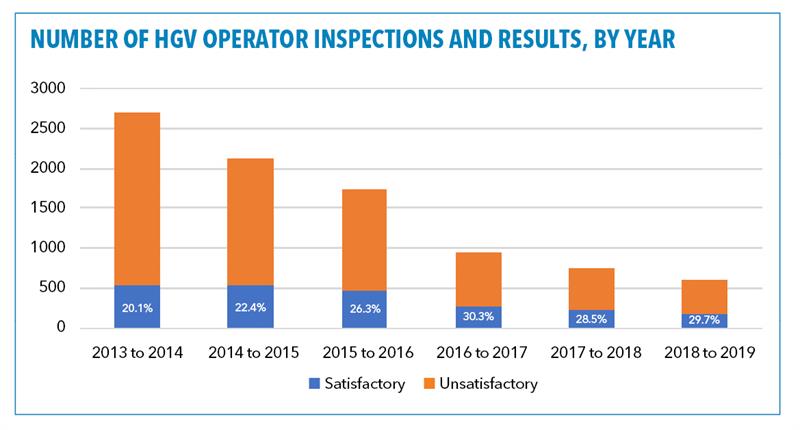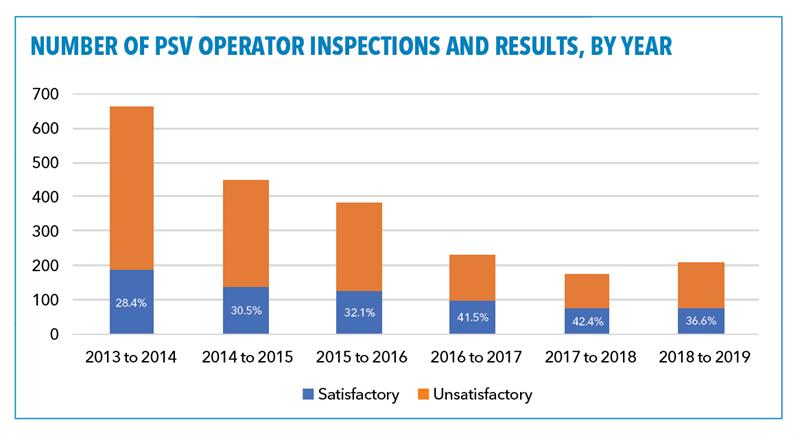As reported in the July issue of Transport Engineer, MOT pass rates have enjoyed an decade of consistent improvement for HGV, PSV and trailer categories (www.is.gd/suyufa). The data reported, as well as the associated commentary, would suggest that the transport industry as a whole is moving in the right direction when it comes to taking responsibility for maintenance.
However, for some operators, ensuring roadworthiness remains out of reach; as a result, maintenance assessments are regularly carried out by DVSA. Agency examiners carry out checks on vehicles and operators every day. Specific maintenance assessments are only carried out on a small percentage of the operators around the UK, but the figures – at face value – don’t make for the most comfortable reading (see table). However, DVSA assures that progress is being made with these rogue operators and that the message that ‘compliance is of the utmost importance’ is getting through.
“To allow us to use our front-line enforcement staff effectively, the assessments – or what we call maintenance investigations – are targeted and prioritised by risk,” explains Dave Wood, DVSA’s enforcement policy manager. “The maintenance assessment compliance rates are typically used to monitor DVSA’s effectiveness in targeting non-compliant operators, and have two main components: a roadworthiness check of the operator’s vehicles and trailers, where a percentage of the operator’s fleet is inspected, and an audit of the operator’s maintenance systems.”
HOW IT WORKS
Wood explains: “Any vehicle/trailer defects are actioned in accordance to the Categorisation of Defects manual [www.is.gd/irukeb], while the maintenance systems audit is based around the requirements of the operator licence and the Guide to Maintaining Roadworthiness.” (See also box) “The maintenance investigation will be assessed against a scoring guide, and an overall score will be given, which determines the assessment outcome and referral action.

“There are a number of triggers that could raise a maintenance assessment. These typically could be dangerous defects found either at roadside checks or in the MOT, intelligence reports, a high operator compliance risk score (OCRS) or complaints,” he adds.
The results are shown below, with a ‘pass’ rate displayed for each year (and computed as the proportion of satisfactory results over the total number of tests). As the data shows, the gulf between satisfactory and unsatisfactory is quite sizeable and, in the case of PSVs, the rate of satisfaction went down from 2017/8 to 2018/19. However, those results do come with a caveat: they typically highlight the worst of the worst, so it’s difficult to read anything in the statistics. Cautions Wood: “Using maintenance assessments is not a valid measurement of industry compliance, as assessment visits are targeted.” For a better measure of the state of industry compliance, he recommends the DVSA’s national fleet compliance report (www.is.gd/zopufu).

Despite the recent questionable performance of operators that have come through these maintenance assessments, DVSA remains committed to finding and ultimately educating – as opposed to punishing – operators who continue to flout the laws. “DVSA’s priority is to protect everyone from unsafe drivers and vehicles,” says the enforcement policy manager. “It’s the operator’s responsibility to ensure their vehicles are roadworthy. If operators follow the recommendations, they will have a robust maintenance system in place to keep their vehicles safe to drive.”
DVSA “constantly engages” with operators, he adds, to help them improve. “We produce publications, provide information and updates in the DVSA Moving On blog and DVSA Direct. New operators are asked to attend a new operator seminar, which provides essential information for operators just starting out in transport; we have a remote enforcement office, which will engage with operators at an early stage if we see indicators of compliance standards starting to slip.”
FINDING FAILING FLEETS
If all of that wasn’t enough incentive to operators to get their fleets in order, Wood promises a greater focus on under-performing hauliers in the future. “We have plans to allocate more resources and to increase the number of maintenance assessments,” he reveals. “But these will be very much targeted towards the non-compliant operator; therefore, we expect to see a high non-compliance rate.
“Unsatisfactory operator assessments are reported to the traffic commissioner for consideration for regulatory action,” he adds. “We are, however, reviewing our policy for operator culpability offence prosecution. For maintenance, this will be where vehicles are used in a dangerous condition and there is a significant failure in the operator’s maintenance system which has caused the offence.”
Wood also encourages operators to aim for Earned Recognition, on the proviso that they play by the rules. “[Being part of the scheme] relies on them having full and effective management control of the transport operation.”
He also ‘strongly’ recommends that technical staff and workshops gain recognised accreditation, either through independent assessment schemes (such as irtec), manufacturers’ accreditations or technical training organisations. Wood adds: “This should not only focus on technical qualification, but also on an embedded culture of continued professional development.”
In the ideal world, there should be no need for maintenance assessments, but some transport fleets continue to fall foul of the rules set out by DVSA. They are the bare minimum that will give operators – and the transport sector in general – a compliance platform on which to build.
BOX: TOP FIVE RULES FROM THE GUIDE TO MAINTAINING ROADWORTHINESS
This large document, available via www.is.gd/nofine, contains so much information that it can be off-putting for an operator looking to improve vehicle condition and maintenance performance, admits Wood. Below, he lists (in no particular order) the five key measures that operators must pay closest attention to in order to ensure their vehicles are safe to drive:
■Effective driver training to ensure walkaround checks and defect reporting are done correctly
■Prompt defect assessment and rectification, ensuring vehicles are taken out of service when required
■Up-to-date maintenance systems, which are adequate to manage the operator’s whole fleet
■Good maintenance facilities and trained technical staff who are competent
■Up-to-date and effective management and quality systems in place.